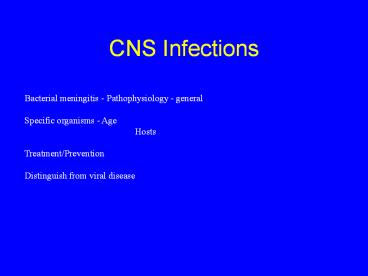CNS Infections - PowerPoint PPT Presentation
Title:
CNS Infections
Description:
Title: CNS Infections Author: Alice S. Prince, MD Last modified by: cuid Created Date: 11/30/1999 9:12:16 PM Document presentation format: On-screen Show – PowerPoint PPT presentation
Number of Views:637
Avg rating:3.0/5.0
Title: CNS Infections
1
CNS Infections
Bacterial meningitis - Pathophysiology -
general Specific organisms - Age Hosts Treatm
ent/Prevention Distinguish from viral disease
2
Meningitis - Neonate
Aspiration - colonization - lack of preformed
Ab Organisms - GBS E.coli K1 (Enteric
bacteria) Listeria monocytogenes Enterococci
Salmonella - fecal contamination Antibiotics
- Cover gram negatives/Listeria/ GBS
3
GBS pathogenesis High grade bacteremia poor
neonatal host defenses (PMN function,
complement function, lack of Ab for
phagocytosis) Meningeal receptors endocytosis
? Intracellular ? Replication
persistence Clinical relevance need for
prolonged therapy ?
4
GBS Streptococcus agalactiae
Common commensal flora childbearing women Lack
of preformed Ab sepsis meningitis in
neonate Early onset disease Sepsis
pneumonia Late onset disease Sepsis
MENINGITIS Vertical transmission most
important - Preventable
5
(No Transcript)
6
(No Transcript)
7
E.coli K1 (not all E. coli - specific
capsular type)
Maternal fecal flora ascending infection CHO
capsule lack of antibody High grade
bacteremia meningitis specific receptors on
meninges - Problem with antibiotic resistance
8
Meningitis - neonate
Listeria monocytogenes - Gram positive bacillus
- motile Found in animal feces - very common
! Contamination of unpasteurized animal
products - organic produce - Mexican
cheese Epidemiology - 2000 cases/year Associated
with a flu-like illness in the
mother Immunocompromised patients - T cell
function
9
Listeria - pathogenesis
Maternal infection
Preterm delivery (not always) Pneumonia - sepsis
- meningitis Intracellular pathogen - ? Lack of
T cell function in the neonate Cell to cell
spread - like Shigella - breaks out of phagosome
- avoids Ab - Need T cell function-
macrophage activation
10
Meningitis - neonate/young infant
Greater incidence of sepsis - immature immune
function Greater incidence of meningitis -
Sepsis work-up - includes LP - difficult to
distinguish viral from bacterial
disease Clinical clues high or low WBC
irritability non specific sxs
11
Very small premature infants Complex congenital
heart diseas Premature infants improved
ventilatory support Coagulase negative
staphylococci sepsis/meningitis Enterococci
selection by antibiotics Fungi
12
Meningitis in infants and toddlers
Case - 4 month old - T- 104 - seen by M.D. - rxd
with tylenol - Still febrile the next day - seen
again, said to have otitis media - prescribed
amoxicillin - Increasingly irritable - Seen
in CPMC E.R.(by clinical clerk) chief complaint
- lump on head - which was a bulging
fontanel - S. pneumoniae in CSF -
13
Arrow - exudate - pus
14
PMNs
Cortex - note edema
meninges
15
Pathophysiology Inflammation Edema
PMNs
Elevated CSF protein
Increased intra- cranial pressure
Loss of perfusion
Breakdown of blood-brain barrier Loss of
autoregulation - BP control
Low glucose
SIADH
16
Pneumococcal meningitis
Sporadic cases - NP colonization - bacteremia -
meningeal seeding - Inflammation - Worst
prognosis Treatment - Achieve 20x MIC of the
organism in the CSF Penicillin MIC 1.0 - need
level of 20 micrograms/ml only get 10 of the
blood level - What to do ???
17
(No Transcript)
18
S. pneumoniae 1999
19
S. pneumo - 1999 data
20
(No Transcript)
21
Prevention of S. pneumoniae infections
Infants/children Prevnar Pneumococcal
Vaccine 8 capsular types protein conjugate
vaccine Immunogenic Effective Adults
23-valent polysaccharide vaccine
22
(No Transcript)
23
(No Transcript)
24
Eradication of a common disease
H. influenzae non typeable otitis acquire
type B capsule Poly ribose phosphate Bacteremia
Meningitis Paradigms for the management of
meningitis
Universal vaccination of infants HiB
PRP-protein conjugate vaccine
Disease gone in vaccinated children
25
Meningitis - Haemophilus influenzae type B
Antibody - polyribose phosphate capsule Allows
efficient phagocytosis Development of conjugate
vaccines PRP - Diphtheria toxin Meningococcal
OMP Sporadic cases - adults who lack Ab
26
Use of anti-inflammatory agents in meningitis
H. influenzae experience - Give
corticosteroids BEFORE antibiotics
Decreases the secondary increase in TNF due to
the release of bacterial cell wall fragments
Improved clinical outcome
? Other organisms ? Other ages
27
Case - 20 year old college sophomore - goes to
nurse with headache, T- 102. Diagnosed as having
flu. Still feels unwell,nurse gives tyelenol
with codeine spends night at dorm - collapses
and is un- arowsable. Sent to local hospital,
T- 103 , WBC -2500 CSF - WBC- 120 - 100 PMNs
Glucose 20/96, Protein- 275. PE - Diffuse
petecchiae, cold, clammy extremities, Poor air
entry...
28
N. meningitidis
N. meningitidis - Epidemic strains/endemic
strains - meningitis belt in sub-Saharan
Africa (type A) Sporadic cases types B, A,
W135, Gram negative (LPS) - Rapid uptake by the
epithelial cells - Receptor mediated endocytosis
Sepsis
Encapsulated - requires IgG complement to
phagocytose
Carriers in the population - increased carriage -
disease in those lacking antibody
29
Gram stain of CSF - note PMNs and intracellular
bacteria
30
N. meningitidis - 1999 data
31
N. meningitidis OUTBREAKS !
Who is at risk ? How is the organisms spread -
carriers? How can disease be prevented
32
N. meningitidis
Development of protective immunity - cross
reactive CHOs commensal flora (Neisseria
lactamica)
Vaccines - (epidemic types) - A and C, Y, W
135 Not B - associated with sporadic
cases Sialic acid epitopes - look like self Who
to vaccinate? College students? Military,
travellers to endemic areas Prophylaxis -
Rifampin, ciprofloxacin, ceftriaxone achieve
levels in naso-pharyngeal secretions
33
(No Transcript)
34
Diagnosis of meningitis - When to do an
L.P. Interpretation of results ONE ANGRY
POLY.. CSF - gram stain Culture
Antigen- detection - latex agglutination
tests Chemistries LOW GLUCOSE Deranged
blood Brain barrier not bacteria eating
lunch HIGH PROTEIN
-
35
Treatment of meningitis
Decrease inflammation Antimicrobial agents that
get into the CSF Fluid CNS pressure
management Septic shock management Public
health considerations
36
Sequellae of meningitis
Hearing loss Seizure disorder Major neurological
dysfunction - Hydrocephalus - obstructed
ventricular drainage Soft neurological
dysfunction Attention deficit disorder Behaviora
l abnormalities































